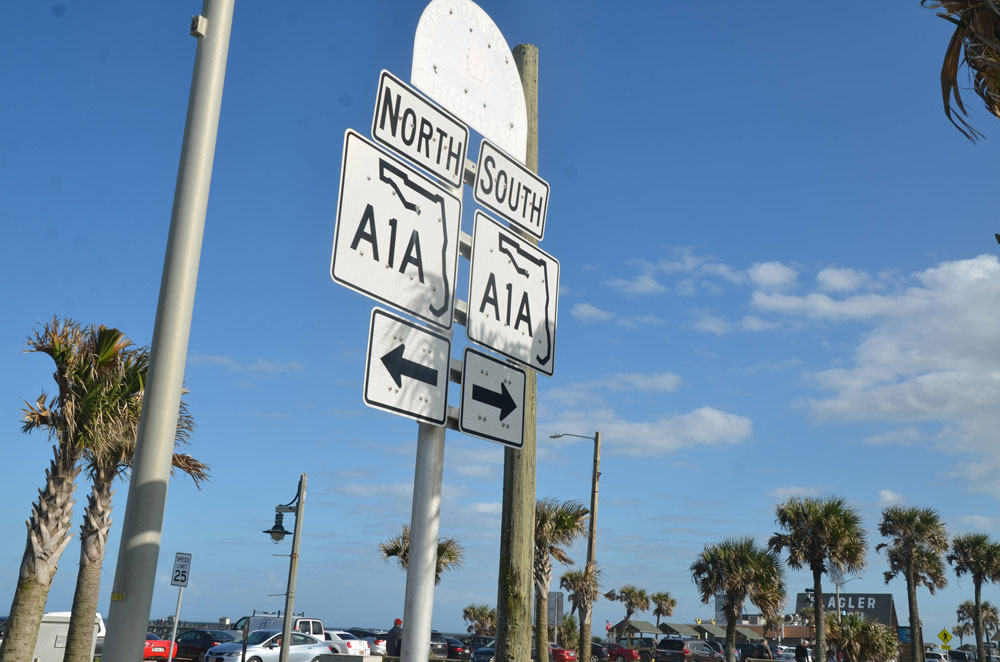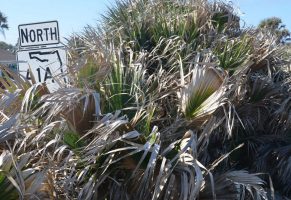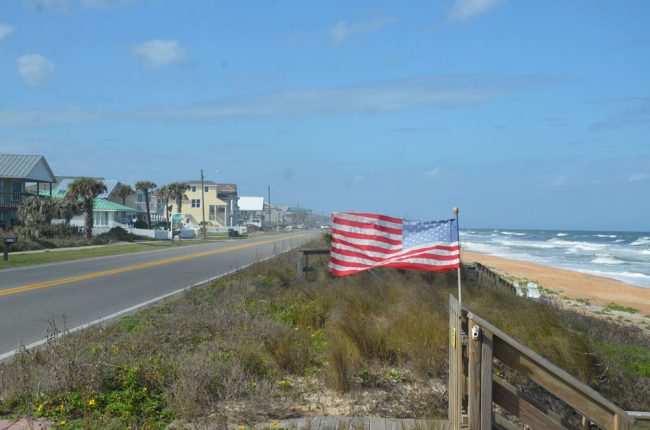
State Road A1A, or at least the region surrounding it even before it took on that relatively recent name, has always had a primordial place in Florida. Originally published in 1939, the WPA guide to Florida devotes its very first tour, out of 22 in the book, to the 102 miles between Jacksonville Beach and Daytona Beach, on what were then State Roads 78 and 140, the previous designations for A1A. The guide described the roads as “hard surfaced roadbed except for occasional short stretches of shell road; watch for cattle and sand drifts.”
Road 140 picked up south of the Matanzas Inlet, and lent itself to the guides’ characteristically exquisite descriptions, though the words now have a museum ring to them: Marine Studios, at the time run by a Russian scientist of storied lineage (his name was Ilia Tolstoy) was “a cream-colored concrete aquarium, pitted with tempered glass portholes, and resembling a stranded Caribbean cruiser.” South of Marineland “the highway plunges into the shade of cabbage palms, oaks, cedars, and bay trees for 6 miles before returning to the shore. The ocean is screened from view, but its presence is indicated by the roar of the surf and the flight of pelicans in single file. Palmetto flats stretch away (R) to the high sand banks of the Intracoastal Waterway; farther in the distance appear smoky-blue forests of pine.” The “(R)” in the guide, like its “(L),” told readers which way to look.
The guide then devotes only six lines to the stretch from the Hammock to Ormond Beach, describing Flagler Beach, with a population of 198 (a New York Times article 30 years later was headlined, “Flagler Beach Has More Sand Than People“), as “a resort frequented by Floridians of near-by inland towns,” with “many old stucco houses and a 600-foot municipal fishing pier.”
The year before the guide appeared, Life Magazine had assigned the great Margaret Bourke-White to photograph U.S. 1 a bit further inland in Life’s attempt to argue against argue against the “hot dog stands, signs, shacks, dumps and shoddy gas stations” that pummeled the road from every sight. The effort was futile, but A1A preserved some of what Life was hoping for. By 1986, Henry Leiferman, fresh from a profile of Frieda Zamba in the Orlando Sentinel, described A1A for the Times as “the golden oldie of Florida’s highways, and the Times in turn headlined it “Florida’s Grand Old Highway.” Leiferman described Flagler Beach’s southern end as “the ultimate surfer hangout,” singling out Snack Jack restaurant, “a 1950s original still doing well.”
The observation hasn’t aged, though the description that followed soon might as Flagler Breach is in for a dumping of a half-million cubic feet of sand dredged from the ocean floor seven miles out that will forever change the complexion of the beach: “There is a walkway down the dune to the beach below the Snack Jack,” Leiferman wrote, “for a look at a rarity, orange sand. The unusual color comes from a huge outcropping of coquina shells off the beach at Marineland. Its millions of tiny shells crumble in the surf and mix with the sand, giving it the orange hue.”
By then Flagler Beach’s population had grown to 2,000, but the drive north remained “a spectacular scenic drive of its own quiet manner,” he wrote. “For 18 miles there is only one high-rise condominium.” He was referring to the Aliki high rise, built off North central Avenue two years earlier, ghastly then, ghastly still. Otherwise it was all “occasional small, mom-and-pop motels, survivors from the 1950s still offering clean rooms with kitchenettes for about $25 a night (common all along A1A0 with desk clerks happy to pass the time with local gossip.”
So the road has been coasting through 20th century quaintness and lesser-known haunts of history for much longer, its footprint likely anticipated by Timucuan lyricists predating European conquerors’ rape-and-plunder era that started in 1513 with the slave and gold-hunting Ponce de Leon–a butcher “greedy of honors and of riches,” as Francis Parkman would describe him in 1865. The burial grounds still being discovered today along A1A are silty testaments to the region’s less scenic memories, which seldom appear on sanitized and upbeat historical markers.
Twenty years ago, when Flagler County’s population was less than half the 115,000 it is today, Florida’s Scenic Highway Advisory Board designated the 18 miles of A1A from the St. Johns to Volusia county lines a scenic highway, the first time a county’s road was so designated from end to end. “It represents an accomplishment of our citizens, our citizens working with businesses and our local government,” Al Hadeed, a Zelig-like creature when it comes to Flagler’s environmental legacy, told the News-Journal at the time, when he was a member of what was then known as the Scenic A1A Corridor Advocacy Group. “The local governments were very important — Marineland, Flagler County, Beverly Beach and Flagler Beach — all four of those governments worked very hard with the citizens and businesses in those corridors to get the state designation.”

(© FlaglerLive)
That was just the beginning. The following year the federal government designated A1A a Scenic and Historic Coastal Byway, one of 27 such roads in the state. And about three weeks ago–on Feb. 16–the Federal Highway Administration declared 72 miles of A1A, including all 18 in Flagler, an All-American Road, one of just two such roads in Florida, and 60 in the nation. The 106-mile Florida Keys Scenic Highway that threads through the Keys was so designated in 2009.“As President of the A1A Scenic & Historic Coastal Byway, it was an honor and a privilege to be awarded the designation of All-American Road,” Marge Rooyakkers said in a release the day of the designation. “I want to thank our board for all of their contributions. This would not have been possible without the hours of hard work done by our byway administrator Danielle Anderson.”
“The designation application was a labor intensive process, especially as the world was grappling with the emerging coronavirus,” Anderson said, enumerating her thanks to those who made it possible.
Hadeed, the county attorney, was among those celebrating the designation. “A1A and its beaches are a keystone to our economy and way of life,” he said. “The A1A scenic byway is sustained and championed by a near universal coalition of active volunteer citizen groups and local and state agencies. The All American Road designation honors the continuing efforts of these stakeholders, sometimes in harmony and sometimes at odds, on how to sustain this local, state and national treasure. But always, the stakeholders strive to enhance the uniqueness of this ‘Old Florida’ coastal corridor.”
Amy Lukasik, the county’s tourism director, said “visitors taking this scenic road often discover Flagler County by accident and are pleasantly surprised that Old Florida still exists. I know that Danielle, Marge and the entire Scenic A1A group work tirelessly to help promote tourism and we are lucky to have such good partners to help our overall efforts.”
Mark Falzone, president of Scenic America, told FlaglerLive that a Scenic Byway designation “definitely brings economic development to the corridor. For example, the Blue Ridge Parkway brought $1.4 billion of economic activity to local area. Also, a story in Colorado just mentioned that Colorado’s scenic byways contributed $4.8 billion to the economy over a six-year period.” He provided a link to other similar economic studies.
Economic impact studies should not generally be accepted at face value. They can be tendentious, they can have hidden motives and they can be wildly inaccurate. But setting hard-numbered if rosy projections aside, the trend unquestionably points to an economic benefit from a scenic designation, and to other benefits. “Indeed,” Falzone said, “A1A received a whopping 19 grants over 20 years totaling $3.6 million for Flagler County Greenway, Flagler Beach, scenic overlooks, a visitor’s center, and wayfinding signage (among others).”
Asked if the designation could have unintended consequences, such as drawing the sort of popular interest that would hamper or diminish the very quaintness visitors are coming to see, Falzone said that was unlikely. “On the other hand, Scenic America successfully advocated for the program to receive funding for the first time in nine years. That funding can be used for anything from improving the roadway to building a visitor center, to designing an educational brochure.”
The threat to the road is not likely to come from visitors but from the very same government agencies that were celebrating the designation–namely a county commission that’s been especially bullish on commercial and residential development along A1A’s unincorporated stretches.
So there was not a small amount of irony when Commissioner Greg Hansen, marking the designation with a public recognition at last Monday’s County Commission meeting, read the remarks that had been prepared for him: “It is more than a beautification award,” Hansen read. “It signifies that A1A possesses features that do not exist elsewhere in the United States, features which are unique and important enough that our byway is a travel destination in its own right. This designation will help promote tourism and our local businesses that depend on it. Scenic byways and all-American roads support the nation’s small business community and our economic drivers for the entire region. This intrinsic quality of this travelway, both historic and recreational, are distinct and precious due to their rarity. And it may seem obvious to any of us that have experienced A1A that the roadway is one of a kind.”
The words could have been spoken–and, in various form, have repeatedly been spoke–to the commission by A1A advocates again and again as the commission was preparing to approve developments that seemed out of kilter with the road’s character (and designations).
One of those advocates, Dennis Clark of the Hammock Community Association, spoke to the commission after Hansen did, subtly calibrating his words between the grateful and the cautious.
“I live on the scenic byway,” Clark, whose association has been among the commission’s more formidable legal foes in the past few years, suing over development it considers overzealous, said. “This is an amazing thing that’s been done. The people who really worked the hardest on it are not me, but people like Danielle and Marge. This is an extremely and valuable asset, which in Florida puts us in an exclusive club with the Florida Keys scenic highway. That’s only two in Florida. We should recognize that people have enjoyed living in this area since the Timucua. An ancient burial site was recently discovered at Jungle Hut Road.”
On that funereal note, Clark continued with flattery metered to caution: “The reason we have this exceptional designation is because a lot of dedicated people, including the board of county commissioners, recognizes the value of preservation over a long period of time–preservation of history and archeological resources, preservation of scenic beauty, and the preservation of natural resources. We need to keep this in mind as we move forward with so much pressure on building and commerce. You knew I was going to say that, right? We could very easily lose this precious resource within a decade or two if we don’t protect it, so we are depending on you.”
That dependence has been tenuous of late.
Then again, it has always been so in Florida when it comes to the state’s roadside fauna. “Although signboards ruin many beautiful stretches of country, they are, in fact, a significant part of the Florida scene,” the same 1939 WPA guide warned, describing this area of the state at a time when guide writers did not automatically associate tourism with the worship of commerce, especially when it turned the scenery crass. “In rural upper Florida one sees crude notices of patent medicines or of ‘Mules for Sale.’ In the vicinity of St. Augustine a great deal of early history is presented on roadside signs, and farther south the flora and fauna are similarly publicized for commercial purposes. Nearly everywhere gastronomy and distance are combined in directional markers that announce ’11 miles to Guava Paste’ or ’13 miles to Tupelo Honey.’ The name of a popular brand of malaria medicine appears on tin signs attached to thousand of trees, but the manufacturer complains that business has been ‘terrible’ since mosquito control became effective.”
Today signs continue to multiply like loaves, joined with frequent irony by equally intrusive and gaudy signs that boast of A1A’s scenic designation or its scenic spots, even when unwanted.
![]()






























mark101 says
Not loving the slow traffic and the major build up of subdivisions down this road, what was, ain’t NO more. IF you gaze out the window you are libel to get run over by tourist and locals trying to pass in a no passing zone. I’ve been here for 54 years and it sure ain’t what is used to be. Peaceful is only noticed after midnight till dawn. .
Happening now says
You are so right.
can't believe it says
As a Florida native, I have been frequenting Flagler County for over 50 years, and a property owner for over 20. I never thought I would see a trashy named pizza joint called “Bronx Pizza” (another business enterprise of Mike Goodmans) being built along our scenic byway, and now “An All American Road” (only the 2nd one in the State). This is a reflection of a County Commission that is so greedy for business in the County, they will promote anything presented. These inappropriate businesses bring no significant job opportunities, and they destroy the uniqueness that people come here to experience. After they have turned it into another Daytona or Orlando (or one of the cesspools up north they escaped from) people will no longer be interested in visiting our area, they will go elsewhere to find what they are looking for. Al Hadeed should be ashamed of himself for touting his support of protecting A1A, when he has been so involved in destroying it. It is ridiculous for Greg Hansen (whose district this is) to read a statement, pretending he is concerned about protecting the area, when he is first to vote for a new restaurant and liquor bar in the middle of Bing’s Landing, (a public park) giving boat parking away, and couldn’t wait to get his signature on the lease to give it away to his friend (Mike Goodman) who is a member of The County Planning Board, and is now suing The County. You’ve got to ask yourself “does this sound right?” Could it be it greed, or something else?
Mark A says
Absolutely agree. Hypocrisy of the Commission is astounding and sad .
Gill says
Flagler destroyed itself, all houses and blacktop roads. Looks like Jacksonville now. All the natural beauty is gone, almost all the trees and landscapes gone!
marlee says
One more story……
Late November 1831, John Audubon traveled from St. Augustine on horseback 35 miles south to the sugar plantation of Gen. Joseph Hernandez on the Matanzas River. Hernandez was the territory of Florida’s first delegate to Congress.
The site of the plantation is Washington Oaks State Gardens on State Road A1A, south of Marineland.
capt says
What a pathetic excuse of a story. This road A1A is turned into nothing more than a place to stick a money making business, there is NO preservation. What we have in some areas is state and federal owned land that no doubt one day in the future will be sold to make high raises or subdivisions. All of these ” promotion stories” in mag’s and in the media is nothing more than a writer and media poly to get out of staters to move here along this road. Incoming new owners in nothing more than tax money and economy promotion. Not preservation of anything of beauty. That died a long time ago as noted in some early post.
Flo-Rida NPC says
The only road on the island of Palm Beach is also A1A. “Old A1A” is only visible at extreme low tide about 40 yards from the shore. It’s the bane of many surfers, I personally have a couple scars from bouncing off it. Do we also get this designation? Probably not, but we don’t want tourists anyways, we’ve been trying to kill the public beaches for years because of the traffic nightmare they create.